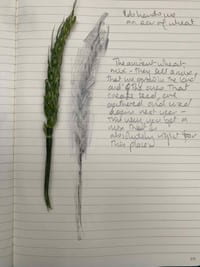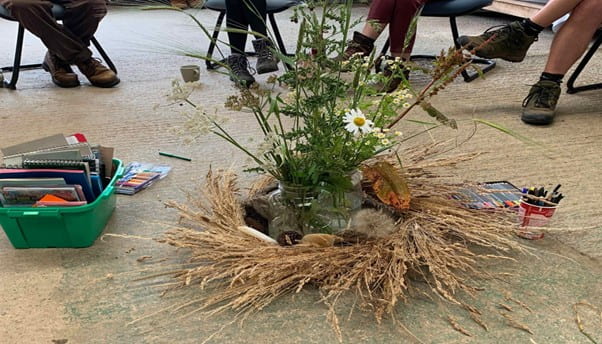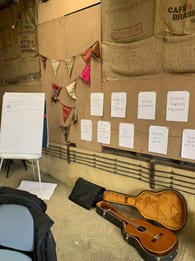Relearning Interdependence was an exploration into how we step back into a restorative relationship with our landscapes. How do we find a way of being that sustains ourselves and the landscapes we permeate?
We knew from very early on that this exploration needed to be multifaceted. We needed to find multiple ways to ask and answer questions and we wanted to hold creativity throughout the process.

Sarah Hinds and Rowan Hyde were part of the core team that held the process all the way though. They attended our meetings, they reflected with us, they planned sessions, they facilitated us as a group at the same time as bringing themselves as members of the community and part of the landscape in which the farm exists. Somehow alongside all of this they created art that reflects the process we were all on.
Rowan produced a zine that used photography, drawings, words and poems to share some of what happened over the project.
When asked to reflect on the making the zine Rowan shared the following words “ I used the notes taken by the researchers to form the text for the zine, and as inspiration for the poems. Combining this with photographs, and the drawings and writing made by participants to capture some of the essence and themes of each workshop.”

Sarah brought her song writing to the process. Both within and outside of the workshops she created songs that represented the conversations we were having and the experience we had on the farm as a group. Below is a short video showing Sarah’s performance at the last session of the project.
Sarah’s reflections on the project are below.
——-
For two days I camped at High Leas farm with the intention of slowing down to listen to the farm. I began by walking around with no goal in mind other than to notice what I experienced. As I walked I carried a note book to record words as I walked:
‘Ant nests, hazelnut shells, blue sky, swallows, disturbing a bird-what is it?, heat, red colours of dock flowers, sound of grass in the wind, feel of wind, warm, purple of thistle flowers, haze of purple, fritillary, sound of insects, buzz, hum, heat (global warming) nettle stings, thistle scratch, vetch, crunch of dried grasses under my feet, crickets, clover, plantain, sorrel, buttercups, foxglove, hog wort, bees, new tortoiseshell butterflies, paths, paths walked, stories told, lives lived, shade, dappled light on dried oak leaves, fallen stone wall round base of oak tree, dappled light, lost, found, losing, arriving, becoming, community, follow the path, history, what can’t I see?, height, view, distance, Crich Stand, Holloway, ghost, speckled wood, field brown, bark blue butterfly with crumpled wing, oyster mushrooms, bracket fungus/ Holly leaves crunch under foot, am I allowed to be in this field?, what’s that rustling in the leaves?, light falling on rocks, moss, a coming storm, wind. Squeak of trees in the wind, high pitched creak, flies in sunlight, little specks of light darting, shadow, coolness, woodland light, rustle of leaves in the wind, feather in a cobweb, sheep bleat, hill, up hill, down hill, path, route, heartbeat, conversation, laughter in the distance, food, warmth, authenticity, confusion, histories, tears, vulnerability, sadness, loss, flurry of brown butterflies, elderflower, the last ones, horses, fern, dandelion, silver birch, sycamore keys, holly, rowan beech.’
I noticed how hard it was to move away from naming and identifying into experiencing. How I quickly moved away from my phenomenological experience into an attempt to understand or make sense of what I was experiencing. I know that to make music I need to let go of trying to making sense of things for the music to arrive. I also know that for me to connect with the other than human world I need to be in quite a still and open place in myself. If I can’t do this I don’t really hear anything beyond what I’m projecting onto the world.
I wanted to listen to the rhythms of the farm and throughout my walk I noticed the song of the birds. When I camped the birds were really loud in the morning. I can only recognise a few bird songs so I listened without trying to identify them, hearing the sound and the call and response. I stayed in the farm the second night as there was a storm and the tent leaked but the next day the song of birds struck me again as a voice of the farm. Everything on the farm has it’s own voice.
I repeated the songs to myself as I walked around and recorded bird song on my phone. Later I began to copy and simplify the rhythms in singing and on the guitar. I was interested how when I played the rhythms on the guitar the repeated pattern reminded me somehow of chants or the repetition in ritual. Bird song came into some of the earliest surviving pieces of British folk song like the 13th century song ‘Sumer is icumen in’ which copies the song of the cuckoo, and it feels like listening to the farm might be able to bring us back in connection with our history. Initially I played with adding these chant sounds to the main song but due to the time limit to get the song ready for the final workshop I decided to leave them for later. I hope to create a separate piece, like a kind of vocal chant. I wonder if these chants could sit somewhere between linguistically meaningful and meaningless and help to get away from the mind trying to make sense of things.
While at the farm I improvised on the guitar and followed a bass rhythm of open E string. This felt like it connected with the feeling I experienced while walking round the farm of rock and earth and history, I wanted the sound which represented the voice of the rocks to have a bit of gravitas. It needed a repeated low note. The rest of the peace was created based on the experience of walking round the farm, the voice of insects and wind and grass, the heat, the repetition of walking and going up and down hill and the feeling of history of the industrial revolution in the background.
The words to the spoken part were based on what I wrote in my note book (above) combined with words and themes which Miriam thought were important: stone, migratory birds (swallow and woodcock) filed names, wheat, barley, weeds, sheep and people.
I also included words which came from the second workshop, the improvisation which I created at the end of this based on the words which people had written and some of the questions which the workshops were trying to address.
The final lyrics were:
What can we see here?
What can we hear
How can we be here?
This place is near and far away.
What is our work here?
How can we grow?
Where is the heart here?
What do we need to know?
What has been lost here?
What can be found?
What are the bones here?
What lies beneath the ground?
The swallow and the woodcock,
The shearing of the sheep,
A harvest to meet with the barley, weeds and wheat,
The naming of the fields is heritage to keep.
There’s a story, a story in the stones,
There’s a tale, a tale in the footpaths,
The seasons of the people, the present and the past.
What can we see here?
What can we hear?
How can we be here?
Let’s start the story here.
Going forward I plan to explore the music based on the bird song. If chants came before language the song of birds might give me a way into making music which steps aside from the rational mind and away from lyrics which communicate concepts or name or define things. I’d be interested to play with harmonies so people can sing together. To have songs based on the birds of the farm sung by groups of people would move away from music as performance to more of a communal activity. I’ll be interested to see if I can do this in a way which isn’t too abstract or conceptual and which can include people who take part in life at High Leas farm.

As we stand, nearly a year on from the start of the Brigstow funded project the relationships built in this process live on. The connections between people and place that are captured in the work above are growing and evolving. The role creativity, song, craft and the relationships they build are still shining a light in our search to relearn interdependence.
Find out more on the Heartwood social farming website.




